Naturally
March 1 was the first day of meteorological spring. The golden-yellow of weeping willows is evident now. Want an adventure? Step outside. Go for a walk. I go outdoors and come back inside a different person.
What to my wondering eyes should appear—I saw only two bald eagles while driving to town and back. Eagles used to be something I didn't see every day. Now, someone could be heard saying this about an eagle, "That's something you see every day."
I watched trumpeter swans. The DNR Nongame Wildlife Program collected swan eggs in 1987-1988 from Alaska. A couple of friends of mine, Carrol Henderson and Steve Kittelson, were instrumental in this endeavor. The eggs were incubated and the cygnets reared at Minnesota's Carlos Avery Wildlife Management Area in Anoka County until they were two years old, and releases began in 1987 near Tamarac National Wildlife Refuge in Becker County. Releases would continue for over 20 years at Tamarac NWR and other sites. Swan Lake in Nicollet County, known as Manha tanka otamenda by the Sioux (“Lake-of-the-Many-Large-Birds”), is where trumpeter swans were first documented to be nesting in the United States. There is an estimated population of 65,000 adult trumpeter swans in Minnesota.
Jay or Jake?
It wasn’t "Love Train," a 1982 hit by the O'Jays. What I heard were blue jays, handsome birds with substantial vocabularies. The vocal birds like to hear themselves squawk. What I heard were pumphandle calls or queedling. “Queedle, queedle.” The musical call has been likened to the sound of a squeaky clothesline, whistles or a complaining pumphandle. Jays learn the call of a hawk species that inhabits an area, and then mimic it when they near a feeding station. That often causes the birds at the feeders to scatter, allowing the jays to have their pick of the food. An aggressive blue jay uses its loud calls (“jay,” “jeeah,” “queedle, queedle”) to alert others to danger. It’s unknown whether jays develop this ability to warn others that a hawk is close or as a manipulative device. Many blue jays might be named Jay or Jake. The purpose of pump handle calls is to communicate distress or alarm. Blue jays emit these calls when they sense danger and when they want to alert other members of their flock of a potential threat. The nature of the call catches the attention of other birds and prompts them to be alert.
Q&A
“Do birds have regional dialects?” Birds sometimes make mistakes when copying an adult. Other birds copy a mistake, and a local dialect develops. Dialects can also be created as birds adapt to a local environment. Birds that are heard better might find mates easier, meaning their song is more likely to be handed down from generation to generation.
“Will this be a bad year for ticks?” Whenever there are warmer temperatures and less snow, it’s better for ticks. In Minnesota, adult ticks usually emerge once the snow has melted and they reach their peak during May. There’s a second period of activity in fall, before temperatures dip below freezing again. While a mild winter might mean more ticks, it may lead to fewer mosquitos due to a lack of precipitation and standing water. But that could change.
“Is it really against the law to lock your car in Churchill, Manitoba, in case someone needs to escape from a polar bear?” If you Google it, there will be about 2,080,000 matches saying that’s true. It’s not. It’s not an official law, but most people do this. Roads lead less than 20 miles outside Churchill, so vehicle theft is not an issue. It’s customary for the inhabitants of the “polar bear capital of the world” to leave doors unlocked, but it’s not imposed by law according to the Royal Canadian Mounted Police. There is an estimated population of 935 polar bears in the western Hudson Bay area, where Churchill sits. As a response to the frequent bear visits, the town established a polar bear alert program. A team tranquilizes the animals if they enter town and takes them to a polar bear holding center, known by locals as the polar bear jail.
Thanks for stopping by
“Without birds, nature would lose her voice and the planet its most engaging envoys. Birds matter precisely because they matter to us. Environment is a concept. Nature a label. Birds are real, elements that live within our sensory plane. They spread their wings and bridge the gap between our world and the natural world.”—Pete Dunne.
“When life becomes heavy and worries pull me down like gravity, I simply look up and suddenly there, in the weightless free air, soaring like kites, flitting from branch to branch, unencumbered, my friends the birds release my soul and I am again free.”—Carl Schreiner.
Do good.
©️Al Batt 2024
The American goldfinch is the state bird of New Jersey, Iowa and Washington. It’s sometimes called a “wild canary” because of the bright yellow plumage the male wears part of the year. Goldfinches are vegetarians and molt their body feathers twice a year, once in late winter and again in late summer. Its contact call, often given in flight, sounds as if it’s saying “po-ta-to-chip.” Photo by Al Batt.

